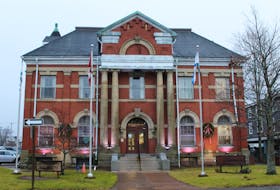If New Glasgow lawyer and property owner Jamie MacGillivray has his way, her image will also grace the side of the Roseland Theatre – the building where in 1946 Desmond was arrested after sitting in a whites-only section.
“Can you imagine when they were arresting her if they thought someday her picture would be on the side of the building?” MacGillivray said Wednesday while meeting with local leaders including MP Sean Fraser, New Glasgow Mayor Nancy Dicks, town councillor John Guthro and Henderson Paris, founder of the Run Against Racism.
While it’s still in the idea stage right now, MacGillivray is hoping he can get government support. He’s open to suggestions, but for now would like to have it feature a modern design with panels on the brick wall.
“We’re trying to find a Nova Scotian with African heritage who is an artist who would be interested in doing it,” he said.
He believes the mural will serve multiple purposes.
“I think it improves the look of the downtown, brings the community together and commemorates a bold and significant act by that lady,” he said.
Dicks said it sounds like a great idea.
“It’s a wonderful honour for a lady who had such an impact on civil rights in our country and province,” she said.
While the incident happened in New Glasgow, the racism that Desmond fought was a problem across the nation at the time and her actions helped bring it to light.
MacGillivray has been doing extensive renovations to the Roseland since purchasing it a few years ago.
He said it’s been a slow process and right now they are working on replacing the roof. The end product will be multiuse, with space for businesses and offices and potentially retail.
“The first thing is getting the shell finished,” he said.
MacGillivray owns numerous properties in and around New Glasgow and has made a point of beautifying as he renovates. He said the goal isn’t necessarily to always look good per se, but to look interesting – “To attract interest and have some character to it. Uniqueness. Something that will just immerse people in it, including tourists and local people too.”
He personally likes the downtown feel because of the way it is open air and people can interact, he said.
By next year, he hopes people will be able to walk through downtown New Glasgow, see Desmond’s portrait on the side of the Roseland and remember the role she played in ending segregation.
Artists interested in taking on the project can call MacGillivray’s office for more information at 902-755-0398.
About Viola Desmond
On Nov. 8, 1946, Viola Desmond was travelling to Cape Breton to deliver her beauty products when she experienced car trouble. She arranged to have repairs made at a garage in New Glasgow, and while waiting, decided to watch a movie at the Roseland Theatre. Viola was arrested and spent the night in jail, charged with defrauding the Province of Nova Scotia. The next day she was convicted of tax evasion and fined.
When she returned to Halifax, she was urged to fight to overturn the conviction, receiving help from the newly formed Nova Scotia Association for the Advancement of Coloured People. She lost her case in District Court and a later appeal to the Provincial Court.
These events sparked debate about human rights in Nova Scotia, and are credited with ultimately leading to the elimination of segregation in the province. In 1954, legal segregation in schools ended, which was the only segregation law in the province of Nova Scotia.
Her story was largely forgotten until the 1990s when legal and civil rights scholars revisited it. Subsequently, her sister Wanda Robson was encouraged to seek a public apology for Desmond’s treatment. Later, Pictou Centre MLA Ross Landry, who was also Nova Scotia Justice Minister, had his department work toward a pardon after a local retired judge brought the case to the attention of a Halifax newspaper reporter.
This led to a Royal Prerogative of Mercy Free Pardon, granted by Lt. Gov. Mayann Francis on April 14, 2010. This was the first time a free pardon has been granted posthumously in Nova Scotia, and is based on innocence and recognizes that the conviction was in error. The Government of Nova Scotia also apologized for the miscarriage of justice.









